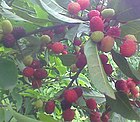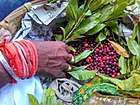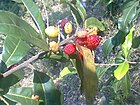Note: This is a project under development. The articles on this wiki are just being initiated and broadly incomplete. You can Help creating new pages.
Myrica esculenta - Katphala
Katphala is a small tree or large shrub native to the hills of northern India and Nepal. It is found in hilly regions of northern India and Nepal especially in the regions of Garhwal and Kumaon of Uttarakhand and western Nepal especially at elevations between 3,000 and 6,000 feet. It is also found at elevations below 1500 m in the midhills of Nepal.
Contents
[hide]- 1 Uses
- 2 Parts Used
- 3 Chemical Composition
- 4 Common names
- 5 Properties
- 6 Habit
- 7 Identification
- 8 List of Ayurvedic medicine in which the herb is used
- 9 Where to get the saplings
- 10 Mode of Propagation
- 11 How to plant/cultivate
- 12 Commonly seen growing in areas
- 13 Photo Gallery
- 14 References
- 15 External Links
Uses
Fever, Asthma, Cough, Rheumatism, Cholera, Blotches, Pimples, Catarrh, Dysentery
Parts Used
Chemical Composition
The fruits of Myrica nagi are known for their ravishing taste and have been reported for reducing sugars, tannins and Vitamin C22, 23.[1]
Common names
| Language | Common name |
|---|---|
| Kannada | NA |
| Hindi | Kaiphal, Kaphal |
| Malayalam | NA |
| Tamil | Cavviyaci, Cavviyacimaram |
| Telugu | NA |
| Marathi | NA |
| Gujarathi | NA |
| Punjabi | NA |
| Kashmiri | NA |
| Sanskrit | Katphala, Mahavalkala |
| English | NA |
Properties
Reference: Dravya - Substance, Rasa - Taste, Guna - Qualities, Veerya - Potency, Vipaka - Post-digesion effect, Karma - Pharmacological activity, Prabhava - Therepeutics.
Dravya
Rasa
Tikta (Bitter), Kashaya (Astringent), Katu (Pungent)
Guna
Laghu (Light), Tikshna (Sharp)
Veerya
Ushna (Hot)
Vipaka
Katu (Pungent)
Karma
Kapha, Vata
Prabhava
Habit
Identification
Leaf
| Kind | Shape | Feature |
|---|---|---|
| Simple | Elliptic-obovate | The leaves are 4-18 × 1.5-4.5 cm, leathery, abaxially pale green |
Flower
| Type | Size | Color and composition | Stamen | More information |
|---|---|---|---|---|
| Small, stalkless | 4.2 cm long | Yellow | 12 stamens | Axillary, bearing about 25 flowers and Flowers Season is June - August |
Fruit
| Type | Size | Mass | Appearance | Seeds | More information |
|---|---|---|---|---|---|
| Globose | 1.1 to 1.3 cm | The fruit is succulent drupe, with a bard endocarp | Weight, 670 mg | Many | {{{6}}} |
Other features
List of Ayurvedic medicine in which the herb is used
Where to get the saplings
Mode of Propagation
How to plant/cultivate
Prefers a moist soil. Grows well in an open position in a well-drained soil in sun or light shade.[3]
Commonly seen growing in areas
Open mixed forests, Mountain slopes.
Photo Gallery
References
External Links
- Ayurvedic Herbs known to be helpful to treat Fever
- Ayurvedic Herbs known to be helpful to treat Asthma
- Ayurvedic Herbs known to be helpful to treat Cough
- Ayurvedic Herbs known to be helpful to treat Rheumatism
- Ayurvedic Herbs known to be helpful to treat Cholera
- Ayurvedic Herbs known to be helpful to treat Blotches
- Ayurvedic Herbs known to be helpful to treat Pimples
- Ayurvedic Herbs known to be helpful to treat Catarrh
- Ayurvedic Herbs known to be helpful to treat Dysentery
- Herbs with Bark used in medicine
- Herbs with Fruits used in medicine
- Herbs with common name in Hindi
- Herbs with common name in Tamil
- Herbs with common name in Sanskrit
- Habit - Tree
- Index of Plants which can be propagated by Seeds
- Index of Plants which can be propagated by Cuttings
- Herbs that are commonly seen in the region of Open mixed forests
- Herbs that are commonly seen in the region of Mountain slopes
- Herbs
- Myricaceae







